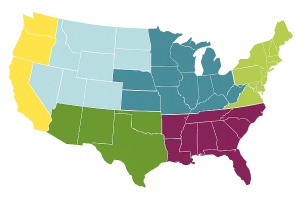Arkansas Native Plants, State Flower & State Bird
Posted By American Meadows Content Team on Sep 27, 2012 · Revised on Oct 26, 2025

Knowing your location helps us recommend plants that will thrive in your climate, based on your Growing Zone.
Posted By American Meadows Content Team on Sep 27, 2012 · Revised on Oct 26, 2025
Native plants are adaptable, low-maintenance, and beautiful. They are the best choice for habitat-friendly gardens and thriving ecosystems. Find top picks for native plants in your state - and learn about your state bird and state flowers!
Follow Along With More Of Our Guides
Hello native plant enthusiasts! In the list below, you will find popular native plants and wildflower seeds, available from American Meadows, that have a native distribution in your state. You’ll also find information about your state bird, state flower, and state wildflower!
Grow our Native Southeast Wildflower Seed Mix!
Virginia Bluebells (Mertensia virginica)
Showy Goldenrod (Solidago speciosa)
Wrinkleleaf Goldenrod (Solidago rugosa)
Texas Bluebonnet (Lupinus texensis)
Black Eyed Susan (Rudbeckia fulgida)
Giant Black Eyed Susan (Rudbeckia maxima)
Black Eyed Susan or Gloriosa Daisy (Rudbeckia hirta)
Purple Coneflower (Echinacea purpurea)
Pale Purple Coneflower (Echinacea pallida)
Yellow Prairie Coneflower (Ratibida columnifera)
Gray Headed Coneflower (Ratibida pinnata)
Butterfly Weed (Asclepias tuberosa)
Swamp Milkweed (Asclepias incarnata)
Common Milkweed (Asclepias syriaca)
White Tinged Sedge (Carex albicans)
Wild Strawberry (Fragaria virginiana)
Plains Coreopsis (Coreopsis tinctoria)
Lanceleaf Coreopsis (Coreopsis lanceolata)
Wild Bergamot (Monarda fistulosa)
Wild Geranium (Geranium maculatum)
Elderberry (Sambucus canadensis)
Phlox divaricata (Woodland Phlox)
Phlox subulata (Creeping Phlox)
Obedient Plant (Physostegia virginiana)
Red Cardinal Flower (Lobelia cardinalis)
Blazing Star (Liatris spicata)
Prairie Blazing Star (Liatris pycnostachya)
Bottlebrush Grass (Elymus hystrix)
Muhly Grass (Muhlenbergia capillaris)
Big Bluestem (Andropogon gerardii)
Little Bluestem (Schizachyrium scoparium)
Northern Sea Oats (Chasmanthium latifolium)
Yellow Prairie Grass (Sorghastrum nutans)
Smooth Blue Aster (Symphyotrichum laeve)
Aromatic Aster (Symphyotrichum oblongifolium)
New England Aster (Symphyotrichum novae-angliae)
Sky Blue Aster (Symphyotrichum oolentangiense)
Ironweed (Vernonia fasciculata)
Common White Yarrow (Achillea millefolium)
Heliopsis (Heliopsis helianthoides)
Purple Prairie Clover (Dalea purpurea)

Mockingbird ~ Mimus polyglottos
The latin name for the Mockingbird means "many-tongued mimic." Besides imitating the songs of other birds, this star performer also sings at great length in phrases that are pure Mockingbird. "Out of the Mockingbird's throat, the musical shuttle," came the song that awakened the poet in Walt Whitman. Indeed, the song of the Mockingbird is a welcome sound to any poet's ear, for this bird has a passion for singing and a beautiful, liquid voice.
Apple Blossom ~ Pyrus malus
Most of the earliest apple trees in the northern part of Arkansas owed their existence to John Chapman, better known as Johnny Appleseed. From Pennsylvania, he traveled to present day Ohio, sowing apple seeds as he went. And thus many of his original apple seeds are reported to have been planted in Arkansas. The Apple Blossom is deep pink in the bud stage, and the open="open" flowers are white, faintly streaked with pink. In most parts of the United States, the month of May is welcomed by everyone as the Apple Blossom month.
From The Wildflowers of the 50 States U.S. stamps issued July 24, 1992:

